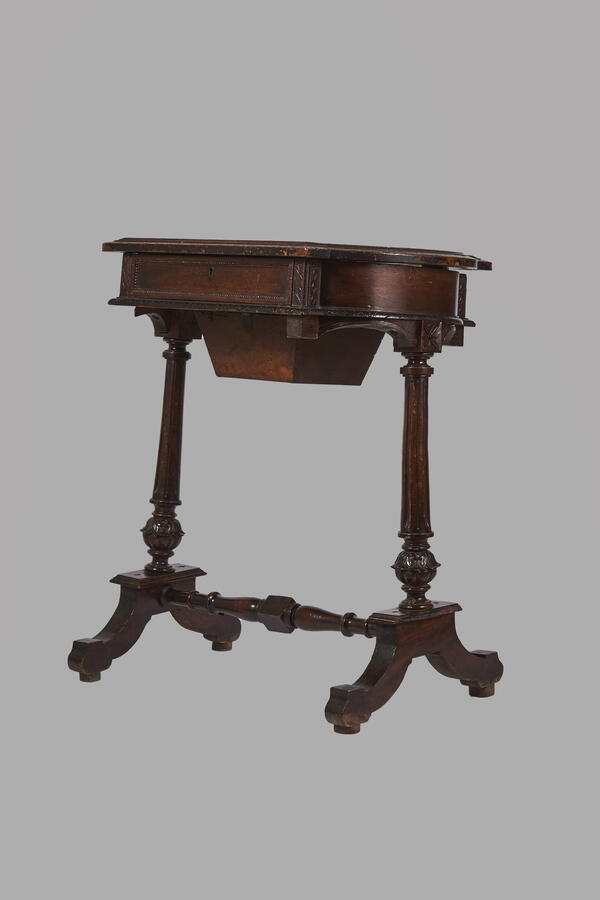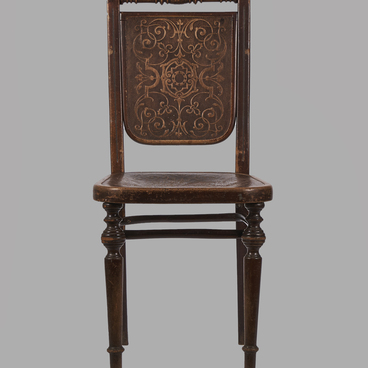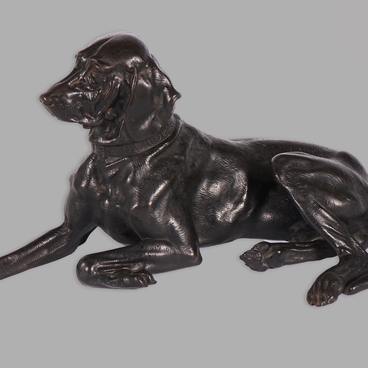Needlewomen often had special places for work. Until the 18th century, women kept needlework and relevant accessories in baskets, purses or caskets. Around 1770, the first “work tables for women” appeared in England — those were elegant tables with drawers. The tables had a silk work bag, sometimes retractable, suspended below, into which women could place their unfinished needlework. Because of the bags, such tables were sometimes called “bag tables”.
In the 19th century, needlework and sewing tables were at the peak of popularity. Such furniture became quite common in middle-class houses. Women’s work tables came in various designs and shapes. Highly decorative and handsome, bizarrely decorated and restrained, extremely fashionable sewing tables became an exquisite piece of furniture. Aristocracy commissioned handmade tables from precious woods, with luxurious decor, inlaid with gold, ivory, enamel, and precious stones. Such furniture was real art.
The work table for needlework was often improved. For example, it could sometimes be equipped with a folding cover, which, if necessary, increased its working surface. Having become a familiar element of the interior, it became a multifunctional piece of furniture and at the same time could serve as a place for writing, drawing, and reading. Such a table could also be used during a game: in this case, the top served as a board for playing chess, backgammon or trictrac. Sometimes the table would be used as a stand for flowers, books or a place for tea drinking. By the early 20th century, women’s work tables had become an important piece of furniture in almost every wealthy home, in Russia and abroad.
This table belonged to the family of Georgy Konstantinovich Kokkinaki. The well-known Novorossiysk family of Kokkinaki had many children, including the famous pilots —Vladimir Konstantinovich Kokkinaki, who became Hero of the Soviet Union twice, and Hero of the Soviet Union Konstantin Konstantinovich Kokkinaki. When the large family scattered across the country came to visit their parents in Novorossiysk, the table was used for playing games and storing crayons and cards.
In the 19th century, needlework and sewing tables were at the peak of popularity. Such furniture became quite common in middle-class houses. Women’s work tables came in various designs and shapes. Highly decorative and handsome, bizarrely decorated and restrained, extremely fashionable sewing tables became an exquisite piece of furniture. Aristocracy commissioned handmade tables from precious woods, with luxurious decor, inlaid with gold, ivory, enamel, and precious stones. Such furniture was real art.
The work table for needlework was often improved. For example, it could sometimes be equipped with a folding cover, which, if necessary, increased its working surface. Having become a familiar element of the interior, it became a multifunctional piece of furniture and at the same time could serve as a place for writing, drawing, and reading. Such a table could also be used during a game: in this case, the top served as a board for playing chess, backgammon or trictrac. Sometimes the table would be used as a stand for flowers, books or a place for tea drinking. By the early 20th century, women’s work tables had become an important piece of furniture in almost every wealthy home, in Russia and abroad.
This table belonged to the family of Georgy Konstantinovich Kokkinaki. The well-known Novorossiysk family of Kokkinaki had many children, including the famous pilots —Vladimir Konstantinovich Kokkinaki, who became Hero of the Soviet Union twice, and Hero of the Soviet Union Konstantin Konstantinovich Kokkinaki. When the large family scattered across the country came to visit their parents in Novorossiysk, the table was used for playing games and storing crayons and cards.





